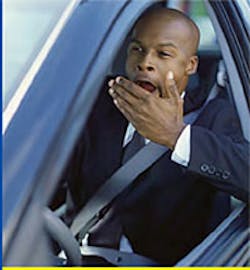This week – November 12 through 18 – is officially “Drowsy Driving Prevention Week,” a joint effort sponsored by the National Sleep Foundation (NSF) and the AAA Foundation for Traffic Safety to educate all motorists about the interrelation between sleep and highway safety.
For example, a recent survey conducted by the AAA Foundation found that young people are more likely to drive drowsy, with one in seven licensed drivers between the ages of 16 and 24 admitting in the group’s poll to having nodded off at least once while driving in the past year as compared to one in ten of all licensed drivers who confessed to falling asleep during the same period.
[The AAA Foundation video below dives a little deeper into this topic, and also notes how highway rest stop policies often exacerbate the “drowsy driving” problem.]
Furthermore, a recent NSF poll found that teens and adults in their twenties reported less sleep satisfaction and roughly one in five rated as "sleepy" on what the group called a standard clinical assessment tool that determines whether sleepiness impairs daily activities.
"Young Americans are sleepy, and this affects their health and safety," says David Cloud, NSF’s CEO. "It's important to get the word out that it's dangerous to drive drowsy. This could save thousands of lives."Based on previous accident analysis, the AAA Foundation estimates that about one in six deadly crashes involved a drowsy driver. The NSF’s 2011 Sleep in America poll also found that among those who drove, about one-half (52%) indicated that they have driven drowsy, with more than one-third (37%) doing so in the past month.
That’s why both organizations are now pushing hard to “wake up” the motoring public about the dangers of driving while drowsy.
Why do both the NSF and AAA Foundation consider “drowsy driving” to be a major highway safety issue? Because they say sleepiness causes slower reaction times, vision impairment, lapses in judgment, and delays in processing information – with a bevy of studies showing that being awake for more than 20 hours results in an impairment equal to a blood alcohol concentration of 0.08%, the legal limit in all states.
Being awake for such long periods also can cause three to four second “micro sleep” periods without a person consciously realizing it – and even a few seconds of inattentiveness of a crowded roadway at high speed can lead to crash.
To help drivers of all vehicles recognize indications of drowsiness behind the wheel, the two groups put together a list of “warning signs” that should signal to folks that it's time to pull over and get rest:
- Difficulty focusing, frequent blinking and/or heavy eyelids
- Difficulty keeping reveries or daydreams at bay
- Trouble keeping your head up
- Drifting from your lane, swerving, tailgating and/or hitting rumble strips
- Inability to clearly remember the last few miles driven
- Missing exits or traffic signs
- Yawning repeatedly
- Feeling restless, irritable, or aggressive
Next, here’s some “preventative medicine” to ensure anyone preparing to pilot a motor vehicle on the highway for an extended period of time can nip “drowsy driving” in the bud:
In a perfect world, of course, we’d all get plenty of sleep and awake refreshed for a new day. But of course that rarely happens – especially in trucking. At the very least, then, it’s important to be aware of the impact of “drowsiness” then try and combat it as effectively as possible.



